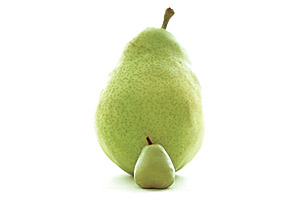
(4 of 4)
Wallet and Palate
But for most consumers — even those who think of themselves as environmentally conscious — the critical considerations in deciding to go organic involve the far more personal matters of price, flavor and nutrition. Last year's nutrient study had a lot of organic partisans wincing — and a lot of commercial growers feeling smug — but one paper is hardly the whole story. The real difference between organic and nonorganic produce is in the relative presence of micronutrients such as copper, iron and manganese, as well as folic acid, none of which were included in the study. With these, the results are mixed.
In a meta-analysis conducted by the Organic Center, a nonprofit group in Boulder, Colo., organic produce was found to be 25% higher in phenolic acids and antioxidants. "It's these components that are deficient in American diets, so that makes this finding especially significant," says Charles Benbrook, the group's chief scientist. But the organic label alone is not enough to ensure that all consumers get the same boost. "The real nutrient value in produce comes from the soil," says Kirschenmann. "So that's a mixed deal unless you know the farmer and know how he's managing his soil."
The farmer also plays the biggest role in determining the most subjective of all variables: taste. You can start a lot of arguments about whether organic crops actually have better, fresher, more complex flavors than industrial crops do, but without a double-blind taste test, there's no way to know. On a few points, most people agree: a freakishly large, overly engineered tomato or strawberry designed to ripen en route to a distribution center will never come close to the taste of its vine-ripened, fresh-picked cousin. The Red Delicious apple is the poster fruit for what can go wrong when commercial growers manipulate their product too much. Bred and rebred for an ever redder skin and an ever more tapered shape, the apples became mealy, juiceless and all but unpalatable inside.
That, however, is not to say organic growers don't also try to prettify their produce before revealing it to the world. "Green markets can be a kind of food pornography," says Manny Howard, author of My Empire of Dirt, about his experiences with backyard farming. "You buy a big bushel of beet greens without a wormhole in it, and that's just not what farm food looks like."
There may be flavor to be found in lovely and unlovely food alike, and a lot of things have to go right to raise the best-tasting produce. It's not just the quality of the soil that's at work, says Kirschenmann. "Selecting the right variety of plant and using the right mix of compost are important too. With farm-to-table food, the farmers are in many ways the chefs, as opposed to, say, molecular gastronomy, in which so much happens in the kitchen."
The kitchen, of course, is the center of everything for families too, and this is where the shouting of the food partisans fades to babble. Eating an apple is almost always better than not eating an apple, no matter where it came from. And getting the whole brood into the habit of sitting down to a meal of lean meats, lots of veggies and judicious amounts of carbs and starches is hard enough without bringing politics into the mix. Farmers' markets are undeniably great — if you can afford them, if there's one near you and if you have time between the job and the kids to make a special trip when you know you can get everything in a single stop at the supermarket. The food industry undeniably churns out all manner of dangerous and addictive junk without a shred of real nutritional value in it, but there are also food companies that manage to get healthy, high-quality food to market and keep the cost of it reasonable.
The answer, ultimately, is for the two sets of producers — and their two sets of customers — to find a better way to co-exist. It's important to crack down on the industry's most egregious and polluting practices — to say nothing of its punishing treatment of animals — but we need to make sure the food still gets to the stores. It's important too to support the local-farming movement not only to make more fresh foods available to more consumers but also to boost a growing economic sector and perhaps bring down prices as efficiencies of scale come up.
"If we all had to concentrate on raising our own food, we wouldn't have time to do anything else," says Howard. Happily, we don't have to do that anymore. But that doesn't let us entirely off the hook. We still have to get smart about what the people who bring us our food are selling, to find the right mix of the commercial and the local, the organic and the industrial. There's a lot more than just groceries on the line — there's health and long life too.
The original version of this article, which appeared in the Aug. 30, 2010, issue of TIME, has been updated to reflect the egg recall.